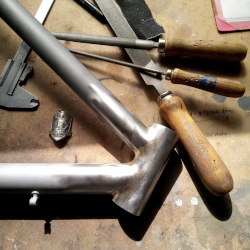The weight of the materials used in the frame obviously influences the overall weight of any frame and therefore of the bicycle.
- There are advantages and disadvantages to the weight of the bicycle: we have historical examples of heavier bikes that have been more successful (and have provided better results for those who used them) than lighter ones, and vice versa.
That said, let's make one more observation, albeit a trivial one: undoubtedly, having a heavy frame doesn't help when climbing hills.
But is this the only criterion you use to evaluate your bike?
If your answer is "yes," let's clarify one thing immediately: if you want a frame as light as possible, you have to buy one made of carbon, the lightest material currently used for bicycles.
But how heavy is a carbon frame?
Well, it depends on the type of carbon used and also on the manufacturing process. You can find low-end carbon frames (more often very risky: see figures)


and also relatively heavy, as well as very expensive and well-made carbon frames that are much lighter (the terms "a lot" and "a little" are relative here).
Let's say that the average weight of carbon frames can be estimated to be around 1 kilogram.
The real fact is that the shape and, above all, the geometry of these types of frames cannot be changed. The frame's design remains the same, and you can only change its color based on the athlete's preferences, but essentially: it's the same colored frame presented differently!
In addition to color, the only thing you can choose in this case is the size. What sizes? The sizes resemble those of inexpensive T-shirts: S, M, L, XL. Sizes that are generally suitable for everyone, but since the Lord, in his incomprehensible talent, has made us all different, there are frames that, in practice, don't fit anyone well!
In short, customization is not possible for these bicycles.
And how heavy is a steel frame?
The answer is: a top-quality frame made perfectly with the right materials weighs around 1.4 - 1.5 kg, so it's about 400/500 grams heavier than the best carbon frame.
However, I have demonstrated with my super light bicycle that a steel bicycle under 6.8 kg is feasible.
And that's it for the numerical part.

In this case, however, the bicycle can be made according to the customer's every desire and can truly be made "ad hoc" based on the client's anthropometric measurements (in other words: truly "made to measure")!
The considerations that should be made are, in fact, also of a different nature, and in particular, we should ask:
- How important are those 400/500 grams?
- How important are those customizations?Tied to a steel rope

- How important is having a tailor-made frame?
- How important is it to personalize it according to your every little preference and athletic characteristic?
We must be frank: there is no single and simple answer to such questions.
As in all things, there are people who go to the tailor to make "their own dress" and those who prefer to buy the label, more and more often produced in China.
In this regard, everyone must make their own assessments and try to find the answers inside themselves.
A technical note
In recent times, I have wanted to prove the concept that with steel, it is possible to achieve performance (in terms of weight and resistance) comparable to those of carbon. This is why I started to make, almost as a joke, a frame that was as light as possible. In the end, I created my new racing bicycle, the one I personally use for rides with old friends and with the new ones who come to visit me in Gesualdo. Do you want to see a complete steel bicycle that weighs 6.4 kg? Then look at the file relating to my super light steel bicycle

On the topic of weight, you can also see:
Maximum weight of an athlete on a steel bicycle?








 Every frame I craft is tailored to your unique needs and preferences, ensuring a perfect fit and unmatched performance
Every frame I craft is tailored to your unique needs and preferences, ensuring a perfect fit and unmatched performance